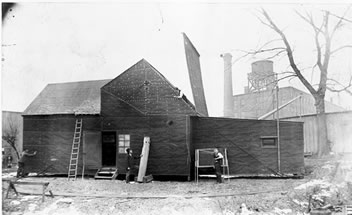Edison's Camera
 Edison built a studio at W. Orange NJ around his camera, the kinetograph.
The studio was called the Black Maria because it resembled a police wagon.
Edison built a studio at W. Orange NJ around his camera, the kinetograph.
The studio was called the Black Maria because it resembled a police wagon.
You need a really good imagination to see the resemblance. Why were police wagons called black marias? There's some more info about that below.
Edison filmed his employees, and vaudeville acts from NYC.
Next: The Kinetoscope
 Learn more about Vaudeville by clicking here (10 minute read)
Learn more about Vaudeville by clicking here (10 minute read)
Get a sense of Vaudeville by watching these two later Vaudeville acts:
The Two Eddies (length: 3:19, required) Lowe, Hite, and Stanley (length: 2:49)
 If you'd like to know a bit more about Edison's Black Maria, here's a Brief extract from PBS's American Experience. (optional, 2:39).
If you'd like to know a bit more about Edison's Black Maria, here's a Brief extract from PBS's American Experience. (optional, 2:39).
If you enjoyed The Two Eddies and Lowe, Hite, and Stanley, you may like Noses Run in My Family (length: 2:01 and at your own risk) a musical number by Benny Bell from the 1940s. Bell (1906-1999) wrote and performed about 600 such songs starting in the 1930s. He had a big hit with Shaving Cream, originally produced in 1946 but revived in the 1970s (and reaching #30 on the Billboard top 100). Bell continued releasing self produced albums into the 1980s.
Here's a bit more about Lowe, Hite, and Stanley. They were Roland Picaro Low (1901-1998), Henry Hite (Henry Marion Mullens 1915-1978), And Stanley Ross (Stanley Rosinski, 1910-1961). Hite was almost 7' 7". Stanley was about three feet tall. Hite was promoted as the world's tallest man and played various (mostly very bad) movie roles. Hite and Lowe started performing when Hite was in his his teens. Ross joined the act later. In addition to dance, they also had comic routines. For example, Lowe would ask Hite "how did you get so tall?" to which he would reply "I eat what's right." Lowe would then ask the same question to Stanley who would reply "I eat what's left." Funny, eh? The act lasted until 1961 when Ross died. After Ross' death, Hite did promotional supermarket tours for Wilson foods' "Corn King" line of meat products. Lowe moved to Chicago where he lived in poverty at a series of hotels, and finally a nursing home. He spent much of his time at Alfredo's barbershop at the Allerton Hotel, where he told jokes and stories to whoever would listen. Accounts of him report that he seems to have been reasonably happy.
I've not been able to find out anything about the Two Eddies.
And the origin of the name black maria? Well, truth is, no one really knows. Here's what's clear. The name black maria (usually pronounced mah-RYE-ah) was used to indicate the vehicle in which suspects captured by the police were taken to jail in cities around the US from about 1840 to the early 20th century. About that time it started to be replaced with the term "paddy wagon." There are several stories about its origin, none of them terribly convincing. One of the stories is that they were named after a black woman named Maria Lee. However, is almost certainly false since she was supposed to have lived in the colonial era and the usage of "black maria" for a police wagon didn't appear until more than 50 years later. And there is no contemporary record of such a person. A somewhat more likely story is that they were named after a racehorse, Black Maria, b. 1826 who won a famous race in 1832. At least the racehorse really did exist, the timing is right, and there's a certain kind of logic (or irony). The police wagons were supposed to be fast (but were probably often very slow). BTW, the name is unlikely to refer to have anything to do with African-Americans. This is because the number of African-Americans in the cities where the term was commonly used was quite low in the 1840s and 1850s: 2-5% of the population. And, "paddy wagon?" That's an anti-Irish slur (people of Irish descent were disparagingly called "Paddys" in the era).
 Edison built a studio at W. Orange NJ around his camera, the kinetograph.
The studio was called the Black Maria because it resembled a police wagon.
Edison built a studio at W. Orange NJ around his camera, the kinetograph.
The studio was called the Black Maria because it resembled a police wagon. Learn more about Vaudeville by clicking
Learn more about Vaudeville by clicking  If you'd like to know a bit more about Edison's Black Maria, here's a
If you'd like to know a bit more about Edison's Black Maria, here's a